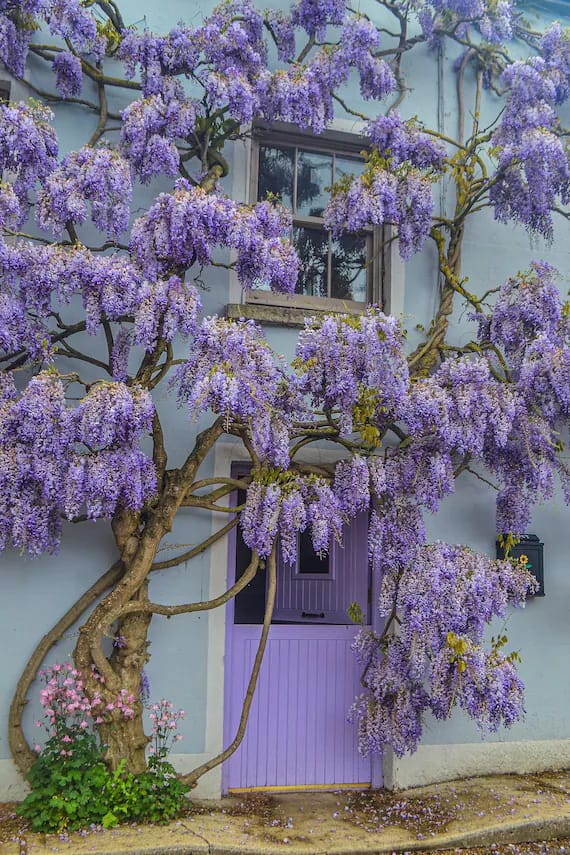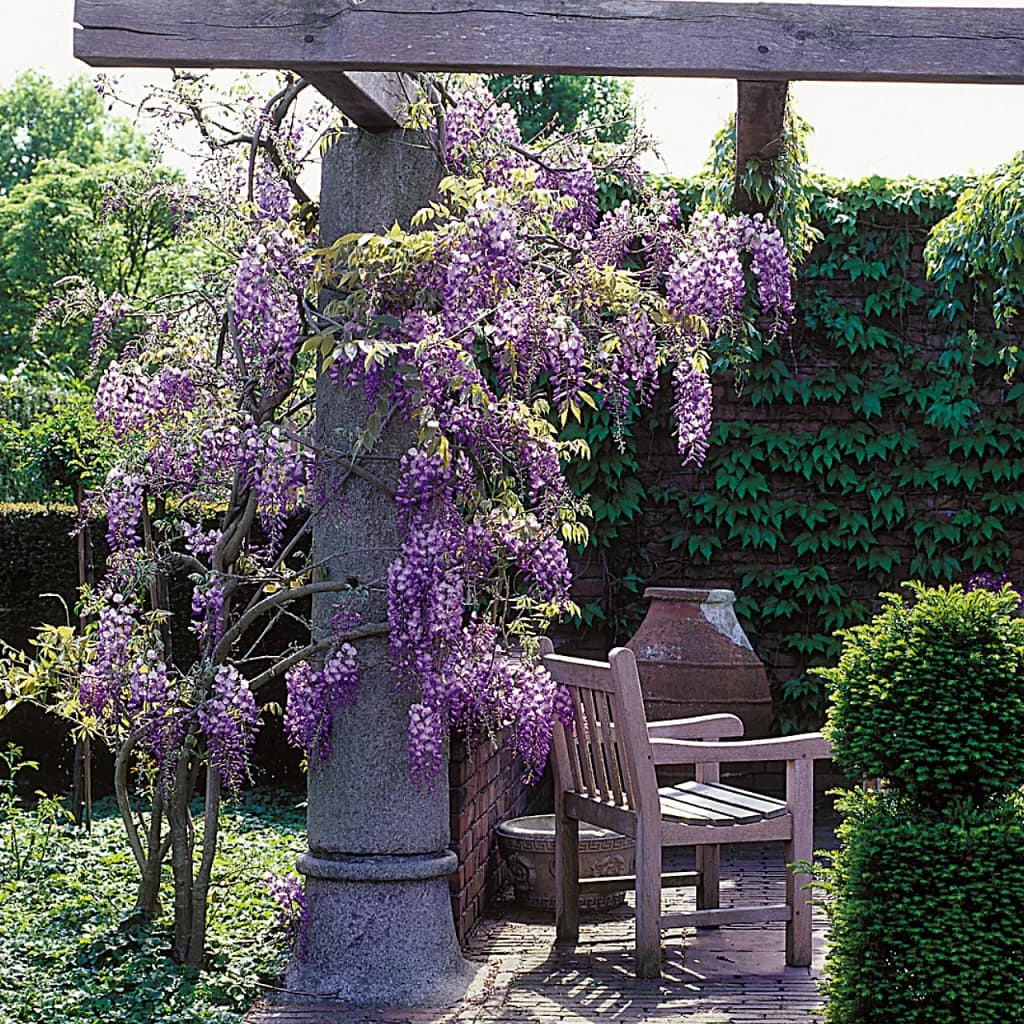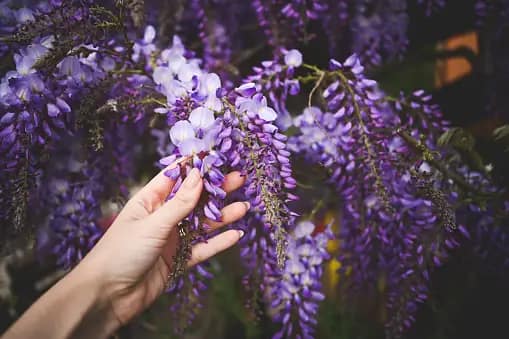Wisteria is a stunning flowering plant known for its cascading clusters of fragrant, colorful blossoms. This plant, which belongs to the legume family (Fabaceae), can be a breathtaking addition to any garden. In this guide, you’ll learn everything you need to know about growing and caring .
Description
Wisteria is a deciduous vine that can grow up to 30 feet or more. Its beautiful, pendulous flower clusters can be up to 12-18 inches long and come in various shades of blue, purple, pink, and white. The leaves are pinnate, consisting of several small leaflets, and the plant’s twisting vines can cover trellises, walls, and arbors, creating a picturesque landscape feature.
known for its enchanting beauty and cascading flowers, holds many secrets beyond its well-known appeal. Here’s a dive into some lesser-known facts and fascinating details about this captivating plant.
Historical and Cultural Significance
Symbolism
- In Asia: Symbolizes love, longevity, and immortality in Chinese and Japanese cultures. It is often featured in art, poetry, and traditional festivals.
- In the West: In Victorian England, wisteria was a symbol of over-passionate love or obsession.
Ancient Uses
- Traditional Medicine: In traditional Chinese medicine, parts of the plant were used to treat various ailments, although modern use is rare due to the plant’s toxicity.
Unique Characteristics
Twisting Habit
- Direction of Twisting: Wisteria vines twist in different directions depending on the species. Chinese wisteria (Wisteria sinensis) twists counterclockwise, while Japanese wisteria (Wisteria floribunda) twists clockwise.
- Growth Rate: It is a fast-growing plant that can grow up to 10 feet in a single year, making it essential to provide robust support structures.
Flowering Oddities
- Blooms Before Leaves: Unlike many plants, wisteria often blooms before its leaves fully emerge in spring, creating a dramatic floral display.
- Rare Second Bloom: Some varieties may produce a second, less intense bloom in late summer, a lesser-known but delightful surprise.
Wisteria’s Impact on Environment and Ecosystem
Soil Improvement
- Nitrogen Fixation: Like many legumes, it has the ability to fix nitrogen in the soil, enriching it and benefiting neighboring plants.
Wildlife Attraction
- Pollinators: Flowers attract bees, butterflies, and hummingbirds, making it a valuable plant for supporting local pollinators.
- Habitat: Its dense foliage can provide shelter for small birds and other wildlife.
Advanced Care Tips
Soil and Watering
- Alkaline Soils: Prefers slightly acidic to neutral soil but can also tolerate slightly alkaline conditions. Adding organic matter can help maintain the right pH balance.
- Water Management: While wisteria is drought-tolerant once established, it performs best with consistent moisture. Mulching around the base can help retain soil moisture.
Pruning for Mastery
- Espalier Techniques: Advanced gardeners can train wisteria into formal shapes using espalier techniques, creating living fences, arches, or intricate designs.
- Rejuvenation Pruning: Older plants can be rejuvenated by cutting back one-third of the oldest stems to the base every year, encouraging new growth.
Myths and Misconceptions
Invasiveness
- Controlled Growth: While wisteria can be invasive in some regions, proper management and regular pruning can prevent it from overtaking garden spaces.
- American Wisteria: Wisteria frutescens is a non-invasive alternative native to North America, offering a similar aesthetic without the aggressive growth of its Asian counterparts.
Toxicity Levels
- Safe Handling: Despite its toxicity when ingested, wisteria is safe to handle. Washing hands after gardening can prevent any irritation from sap.
Propagation Secrets
Air Layering
- Advanced Technique: Air layering involves wounding a stem and wrapping it with moist sphagnum moss and plastic wrap to encourage root formation. This method can be more successful than traditional cuttings for propagating .
Grafting
- Hybrid Varieties: Some rare and beautiful varieties are produced through grafting, combining the rootstock of a hardy species with the flowering variety’s scion for enhanced growth and bloom quality.
Rare Varieties
Lesser-Known Species
- Silky Wisteria (Wisteria brachybotrys): Known for its soft, silky leaves and fragrant, shorter flower clusters.
- Evergreen Wisteria (Millettia reticulata): Not a true wisteria but closely related, this plant offers similar beauty with the added benefit of being evergreen in warmer climates.
Color Variations
- Bicolor Blooms: Some cultivars feature bicolor flowers, with striking combinations such as white and purple or pink and white, adding a unique touch to any garden.

Common Varieties
- Chinese Wisteria (Wisteria sinensis): Known for its vigorous growth and large, fragrant flowers, typically lavender-blue.
- Japanese Wisteria (Wisteria floribunda): Features longer flower clusters and a variety of colors, including white, pink, and violet.
- American Wisteria (Wisteria frutescens): A less aggressive grower with slightly smaller flower clusters, native to the southeastern United States.
How to Plant
Site Selection
Choose a location with full sun (at least six hours of direct sunlight per day) for the best flowering. Plant can tolerate partial shade, but it may not bloom as profusely.
Soil Requirements
Plant thrives in well-draining, fertile soil. It prefers a slightly acidic to neutral pH (5.0-7.0). Amend the soil with compost to improve fertility and drainage if necessary.
Planting Steps
- Dig the Hole: Dig a hole twice as wide and as deep as the root ball of the plant.
- Prepare the Plant: Gently remove the plant from its container and tease out the roots.
- Planting: Place the wisteria in the hole, ensuring the top of the root ball is level with the soil surface.
- Backfill: Fill the hole with soil, gently firming it around the roots to remove any air pockets.
- Water: Water the plant thoroughly to help it establish.
How to Care
Watering
- Frequency: Water newly planted regularly to keep the soil moist but not waterlogged. Established plants are drought-tolerant and need less frequent watering.
- Method: Deep watering is recommended to encourage deep root growth.
Pruning
- Timing: Prune plant twice a year – once in late winter (January or February) – once in summer (July or August).
- Method: In late winter, prune back the long shoots from the previous year’s growth to 2-3 buds. In summer, trim the new growth to about 6 inches long.
Fertilizing
- Type: Apply a balanced, slow-release fertilizer in early spring. Avoid high-nitrogen fertilizers, as they encourage foliage growth rather than flower production.
- Frequency: Fertilize once a year in spring.
Support
Wisteria requires strong support for its vigorous growth. Use a sturdy trellis, arbor, or pergola to support the plant’s weight and sprawling habit.

Plant Diseases and Solutions
Common Issues
- Crown Gall: Caused by soil-borne bacteria, it results in swollen, knobby growths on the roots and stems. Remove and destroy affected plants.
- Leaf Spot: Fungal infections cause dark spots on the leaves. Destroy infected leaves and do not overhead watering.
Pests
- Aphids: These small insects suck sap from the plant. Use insecticidal soap or neem oil.
- Scale Insects: Hard-shelled insects that attach to stems and leaves. Control scale infestations with horticultural oil.
Propagating
Methods
- Cuttings: Take softwood cuttings in late spring or early summer and root them in a well-draining potting mix.
- Layering: Bury a low-growing stem in the soil while it remains attached to the parent plant. Once roots have formed, sever the new plant from the parent and transplant it.
Blooming and Fragrance
Bloom Time
Late spring to early summer. Some varieties may produce a second flush of flowers in late summer.
Fragrance
The flowers of wisteria are known for their delightful, sweet fragrance, which can fill a garden with their perfume.
Toxicity
It is toxic to pets and humans if ingested. All parts of the plant, especially the seeds and pods, contain lectin and wisterin, which can cause nausea, vomiting, diarrhea, and abdominal pain.

